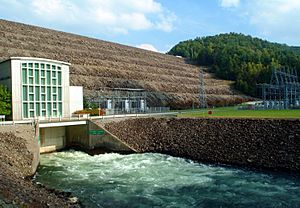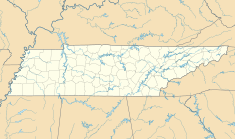South Holston Dam facts for kids
Quick facts for kids South Holston Dam |
|
|---|---|

South Holston Dam
|
|
|
Location of South Holston Dam in Tennessee
|
|
| Official name | South Holston Dam |
| Location | Sullivan County, Tennessee, United States |
| Coordinates | 36°31′24″N 82°5′20″W / 36.52333°N 82.08889°W |
| Construction began | February 16, 1942 |
| Opening date | November 20, 1950 |
| Operator(s) | Tennessee Valley Authority |
| Dam and spillways | |
| Impounds | South Fork Holston River |
| Height | 285 feet (87 m) |
| Length | 1,600 feet (490 m) |
| Reservoir | |
| Creates | South Holston Lake |
| Total capacity | 765,000 acre⋅ft (944,000 dam3) |
| Power station | |
| Commission date | 1950 |
| Turbines | 1 x 38.5 MW Francis-type |
| Installed capacity | 38.5 MW |
The South Holston Dam is a large structure on the South Fork Holston River in Sullivan County, Tennessee. It helps control floods and creates hydroelectric power. This dam is the highest of three dams on the South Fork Holston River. The Tennessee Valley Authority (TVA) built and runs it.
The TVA built the dam in the 1940s. Its main goal was to help stop floods in the Tennessee River area. On October 21, 1950, the dam's gates closed. This allowed water to build up and form South Holston Lake. The lake covers about 7,550 acres (3,060 ha). It stretches from Tennessee into Virginia.
Contents
Where is South Holston Dam Located?
South Holston Dam is about 50 miles (80 km) upstream from where the South Fork Holston River meets the North Fork Holston River. Together, these rivers form the main Holston River. The dam is in a spot where the river flows down from the Appalachian Mountains. It then enters the upper Holston Valley.
The dam and the Tennessee part of its lake are within the Cherokee National Forest. The Virginia part of the lake is in the Jefferson National Forest. The lake is in Sullivan County, Tennessee, and Washington County, Virginia. The city of Bristol is a few miles northwest of the dam. It sits right on the Tennessee-Virginia border.
How Big is South Holston Dam?
South Holston Dam is made of earth and rock. It stands 285 feet (87 m) tall and is 1,600 feet (490 m) long. The dam can produce 38,500 kilowatts of electricity. It has a special "morning glory" spillway. This spillway can release up to 116,200 cubic feet per second (3,290 m3/s) of water.
South Holston Lake stretches about 24 miles (39 km) into southwestern Virginia. It has 168 miles (270 km) of shoreline. The lake can hold 765,000 acre⋅ft (944,000 dam3) of water. About 252,757 acre⋅ft (311,771 dam3) of this is kept for flood control. The lake's water level usually changes by about 23 feet (7.0 m) each year.
The dam has two water intakes. One is at the north end, and the other is at the south end. The north intake sends water through a pipe to the powerhouse. This powerhouse is at the northern base of the dam. The south intake sends water to the spillway. From there, it flows through a channel to a basin at the dam's southern base.
Why Was South Holston Dam Built?
People had been looking into building power plants on the South Fork Holston River since the early 1900s. However, no big projects happened until the TVA got involved. In the 1920s, a company planned to build four dams on the river. One of these was at the same spot where South Holston Dam is now.
The Tennessee Valley Authority took over the Tennessee River area in the 1930s. They suggested building two dams on the South Fork Holston River. One was at the South Holston Dam site. The other was at Cardens Bluff, which is now Watauga Dam. The main reason for these dams was flood control. A big flood in 1940 had caused a lot of damage downstream.
The dams would also make electricity. This was very important because of the high demand for power during World War II. South Holston Dam and Watauga Dam were approved on December 17, 1941. Work on South Holston Dam started on February 16, 1942.
Building South Holston Dam and its lake needed a lot of land. The TVA bought 12,860 acres (52 km2) of land. They had to clear 3,875 acres (1,568 ha) of it. The project also moved 342 families and 559 graves. About 30.5 miles (49.1 km) of roads had to be moved, and four new bridges were built.
In October 1942, the U.S. War Production Board stopped work on the dam. They said it was not vital for the war. Work on the dam did not start again until August 4, 1947. South Holston Dam was finished, and its gates closed on November 20, 1950. The dam's generator started making power on February 13, 1951. The whole project cost over $31 million.
Modernizing the Dam's Power Production
South Holston Dam is one of the TVA's most important power plants in the area. After 65 years, the dam needed to be updated. It used to make 49 megawatts of energy, but that had dropped to 42. The TVA upgraded the powerhouse controls and power equipment. This helped the dam produce energy more efficiently.
What is the Weir Dam?
In 1991, the TVA built a smaller dam called a weir dam. This weir is about 1.5 miles below the main dam. It is an "aerating labyrinth weir," which means it helps add oxygen to the water. Water coming from the bottom of the main dam is often cold and has little oxygen. It can also have strong, unpredictable currents.
The weir helps fix these problems. It adds oxygen to the water, which is good for aquatic insects, plants, and fish like bass and trout. The weir also calms the water. This makes it safer and more enjoyable for people who want to boat, fish, or swim.



